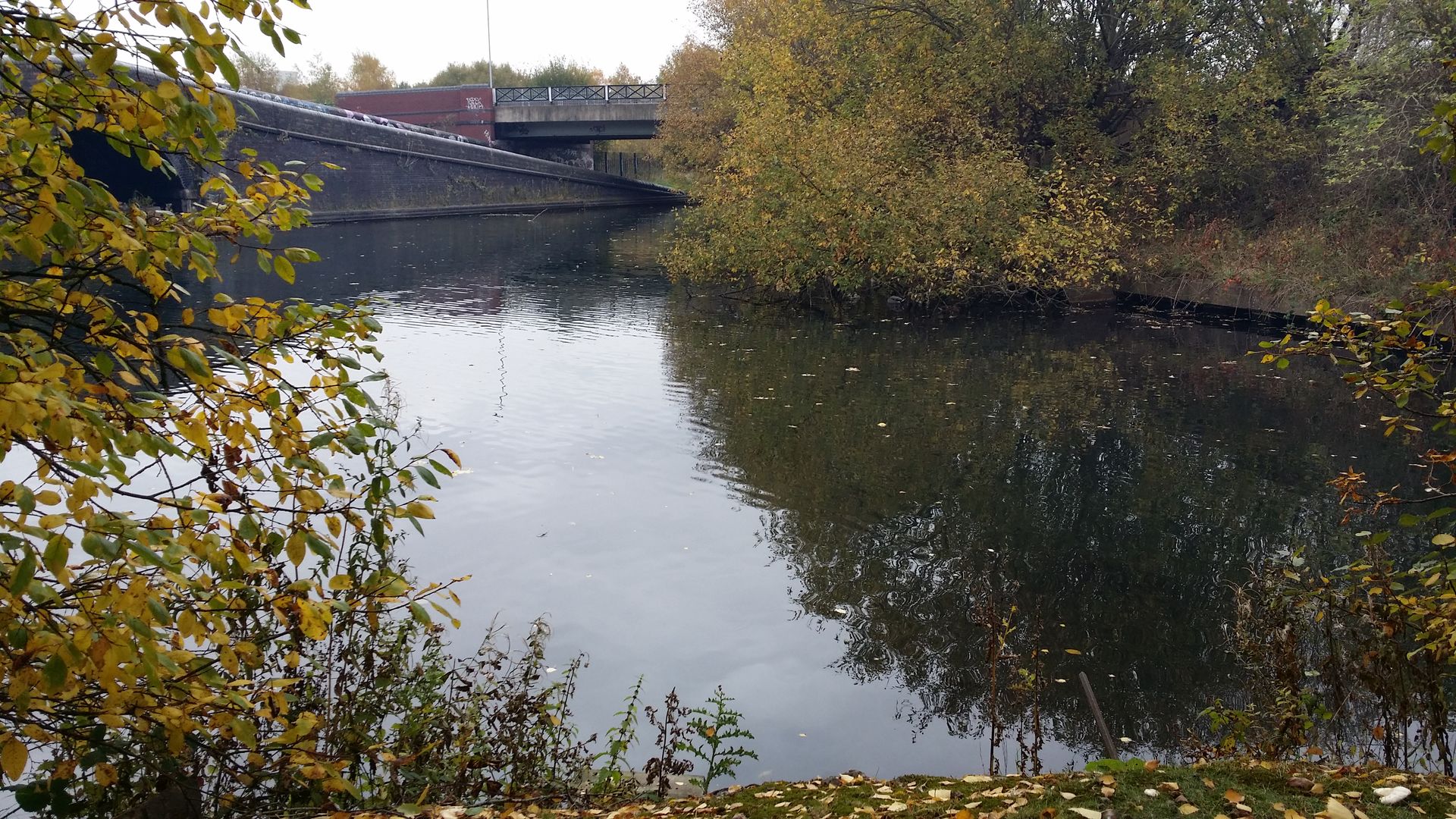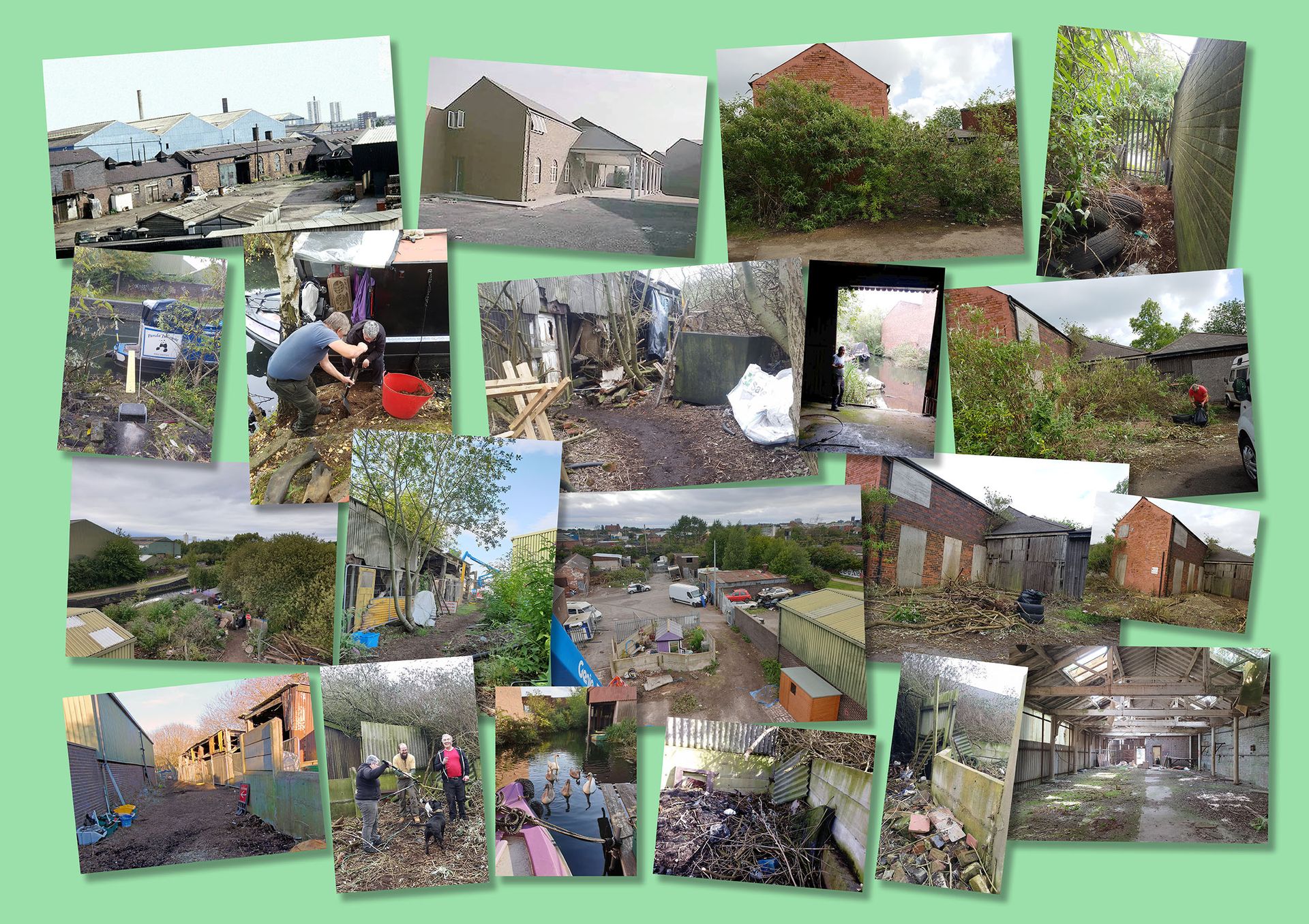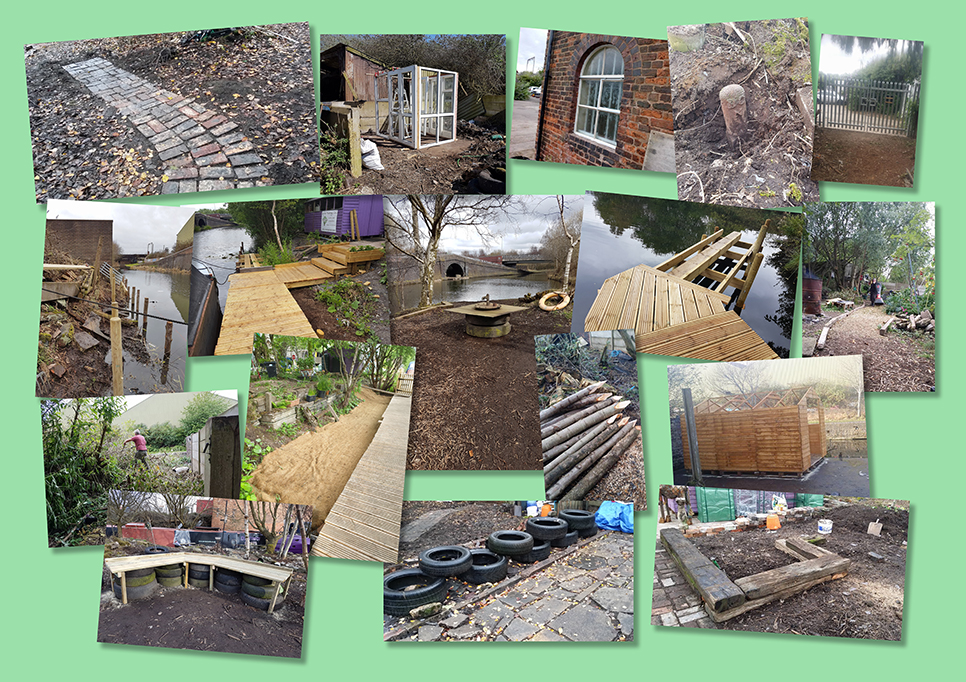Two boats and one Butty (unpowered boat) left Birmingham at about 9am on a cool day in the last week of October 2016 to begin a great adventure. They arrived in Wolverhampton late afternoon.
To say the site they had come to was a mess would be an understatement. A forest of Buddleia, with stems as large as tree trunks covered the place along with countless years of built-up rubbish from fly tipping, the remains of the burnt-out building that once stood there and a long ramshackle, derelict asbestos covered shed.
On the day of our arrival, we had to literally hack our way in. One of the boats, Paul and Jennies’, was moored on the main canal but due to the erosion of the bank edge, it was several feet away from the land and a gang plank was needed.
The other two boats, Alison and Louise’, were going to moor down the canal arm that runs up to the boat house but had to moor against the first boat temporarily as they could not get in until a large supermarket delivery trolly, car seat and lots of other rubbish that had been dumped in the water were removed. There was also a sunken boat in the canal arm but that was passable. Good use was made of ropes, a winch attached to one of the sturdy trees on site and loads of man and woman power to get it all out. It was hard, dirty work. Steps also had to be dug out and made safe so that Louise and Alison could get on and off their boats. It was a long, tiring but very exciting day. That was the first day of Urban Moorings existence. The first of many exciting and rewarding days at Urban Moorings C.I.C.
There are over two thousand miles of canals in this country many of which run through the Backcountry. The canals have a long history associated with the industrial development of the area. The boats transported the raw materials needed by the factories and foundry’s and the finished goods to the rest of the country. Today the canals are mostly used for leisure boats. There is also a large community of boaters who both live and work on the canals. There are place around the canal system that celebrate the history of the canals, the Backcountry Museum in Tipton is one example. There are also smaller projects that are attempting to keep this wonderful resource on our doorsteps alive and thriving. Here is how one group of boaters began to develop a boating and community asset for an area – Urban Moorings. Wolverhampton.
Who makes up the Urban moorings team? The Urban Moorings team is made up of a group of people who live on boats and have cruised our amazing canal system for many years.
Alison is a design engineer. Louise, Alison’s partner, owns and runs a high-end bespoke artists canvas manufacturing business and Ronni is an independent trader specialising in alternative clothing. These are the Directors of Urban Moorings C.I.C.
Jennie, Yogi (Ronni`s other half), John and Rita along with Chris and Kat make up the rest of the team. Each have their own skill sets and life experiences that they bring to the project.
There are also 3 dogs and 2 cats that make up the full compliment.
When did the idea of Urban Moorings begin? The idea of Urban Moorings came about in 2016 when Alison, Louise Paul (Jennies late husband and one of the original directors of Urban Moorings) and Jennie were having coffee and discussing the mooring availability within the area. The idea of a boater led community mooring came up.
Why Urban Moorings? The general agreement was that none of them particularly liked the moorings available and as there were many smallish areas of land around the canal system that would make good community moorings, they would build their own.
The Urban Moorings by line is `Creating Canal Communities`.
Boaters are very resourceful people. They are required to generate their own power, deal with their own waste disposal, collect their own water and be self-reliant when dealing with problems as they arise. Getting mail delivered or general deliveries can be problematic.
It’s difficult to be able to register to vote as even though most people who live and work on/from their boats, own their boats, they are still at present considered to be homeless. But that’s another story. Doing internal alterations or external maintenance on a boat on the towpath is difficult. These things develop a skill set amongst boaters that the team wanted to share with the land-based community as well as providing the services that boater may find helpful.
Currently with more and more people living in accommodation with very limited space and no garden, many folk living on land experience similar problems and may sometimes feel isolated from the community in general.
Boaters are also very good at recycling, reusing, and repurposing “stuff”. Recycling, reusing and repurposing are amongst the central tenants of the Urban Moorings ethos. Again, it is hoped that others may learn from our experience and example.
The team wanted to create a space where boaters and the land-based community could share ideas and skills, dispelling some of the misconceptions and distrust that has built up between the two communities.
Why a C.I.C. the team wanted the project to be self-sustaining. Many projects risk failure if they are completely grant funded and if the grant money runs out, the project folds. Being a C.I.C. Urban Moorings generates a core income from the moorings, coal, gas and diesel sales, fund raising events and donations. We are licenced by HMRC to sell diesel and have all the proper equipment to do so. As a C.I.C Urban Moorings can also apply for grants to help individual projects within the main project but will not be reliant on them.
A business proposal was drafted and presented to Canal and River Trust and after lots of meetings, discussions and initial disappointments, a scrap of unused, derelict land with some access problems was found. Most would have probably just seen an odd bit of inaccessible, derelict, industrial wasteland but four pairs of eyes saw the potential.
Urban Moorings is situated in Wolverhampton on the Wyrley and Essington canal a few hundred meters from its junction with the Birmingham New Main Line. By road its off the A454, the Willenhall Road, just before it reaches the ring roads around the town centre. The main West Coat Main Line Railway passes by as it is next to the main railway holding area for trains coming into and leaving Wolverhampton. There is a low railway bridge at the road entrance and the old underground railway tunnel runs underneath the site.
At first the agreement was with Canal and River Trust to use their piece of land for moorings. This was followed by a series of meeting with Wolverhampton City Council who owned the adjoining piece of land which had an old, derelict boat house on it. Again, four pairs of eyes could see the potential in this space for use by boaters and the community at large. When clearing the site, we also discovered a large building we call the garage and an original canal Toll House that were completely concealed by Buddleia. These spaces have all been incorporated into the business plan for restoration in the future. Happily, both the Council and Canal and River Trust could also see the potential and had confidence in the team to get things done.
Since that first day the site has been transformed. The spot where the first boat moored has been cleared and the concrete pad discovered now provides the base for two sheds. A walkway that follows the original line of the canal bank has been constructed after submitting a detailed works proposal and gaining permission from Canal and River Trust. Stou,t English Alder stakes have been used and all the construction was completed by hand. Rubble from site was used to backfill the eroded area, coir matting placed on top with soil and compost on top of that and now we are creating a meadow like area. All good for the ecology of the area.
Many of the concrete beams (there used to be a concrete manufacturing business here run by a Mr. Perry) have been used for shoring up where needed and creating flower beds.
The sunken boat has been raised and so much rubbish including lengths of Harris fencing, old chairs and big chunks of foam which were cut to size and used as a weed suppressant layer in the base of some flower beds. It never ceases to surprise us the things that get thrown into the canal even old road signs that now make a decorative feature in the garden.
We had many neglected trees on site, Birch, Rowan, Willow, Cherry and one that we are not sure what it is. We employed some local arborers to come and make the trees safe, raise the canopy and pollard the willows. Raising the tree canopy has allowed the light in and encouraged the growth of wild grasses and plants, assisting the local ecology. The Arborers came back later and cleared many of the dangerous and dead trees from the off side of the canal arm. Chris and Kat are doing a sterling job of turning that rubbish filled piece of land into pleasant moorings.
We have numerous bug and BEE `hotels` around the site and this year we have noticed a significant increase in bee numbers.
With the help of Wolverhampton Council, the asbestos covered shed and approximately 65 tons of assorted rubbish has been removed from site.
Planning permission has been gained for the erecting of several wooden sheds. Three large sheds, the Urban Moorings office and laundry room in one, DV Designs Studio in another and a community space for meetings, events and activities incorporating a small kitchen area in the third which is still an ongoing project.
The Hippie Shed is also on site along with the woodworking shed, greenhouse and several small sheds to be used as storage or as the community wants.
Raised beds have been constructed from the old beams taken down when the ramshackle shed (affectionately known as `the shed of doom`) was dismantled. Recycling and composting bins have been constructed from the same materials.
Paths have been laid from bricks dug up on site and edged with stones and cobbles found in the ‘shed of doom’.
A coal store constructed from old pontoons and recycled wood is serving us well.
Trenches have been dug and electricity and water installed.
We aim to provide access for people of all abilities, ages, genders, cultures, races and faiths. Our only requirement is that all prejudices are left at the gate.
Several of the boats moored here have dry (composting) toilet systems. We have shown that dealing with such waste is not rocket science and can be successfully achieved with little space and effort. The resulting compost from our bins has helped enrich the soil so that now where nothing would grow, we have grass and loads of wild and cultivated flowers and plants growing. Such has been our success that Canal and River Trust amongst others have taken a report written on our achievement and are using it as a guide for others to follow.
We have separate bins for food and garden waste which is then used on the raised food beds. Everything we use in the garden is organic. Even the tons of soil we have had to import has come from certified organic distributers. We make much of our own plant food and use homemade bug deterrents and weed inhibitors. Hopefully will be certified as an organic garden by the Soil Association in the future.
We have held two successful Open Days and several volunteering days despite having to close due to Covid. Coffee and Colouring for Grownups was well received. And we held a consultation with the local community to see what they would like Urban Moorings to provide.
Working with the consultation in mind, future plans include a community run café, secure sensory garden with public BBQ area, history and nature walks and various workshops such as creative writing, art classes, as well as men and women only activities yet to be determined.
A community run Trip Boat has been suggested and well received by the Urban Moorings team.
Three members of the Urban Moorings team are undertaking Walk Leader training with Sustrans UK with whom Urban Moorings have a good relationship with.
Urban Moorings is in negotiations with Wolverhampton council as how best proceed with the restoration and bringing into use of the Boat and Toll houses, both of which date back to the 1800`s.
So Urban Moorings has come a long way since that cool day in the last week of October 2016. But there is still a long way to go.
That again is another story.


